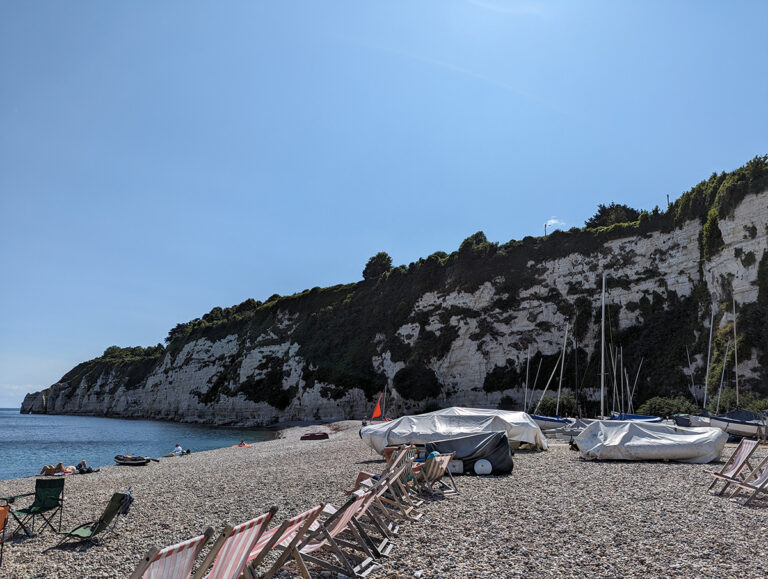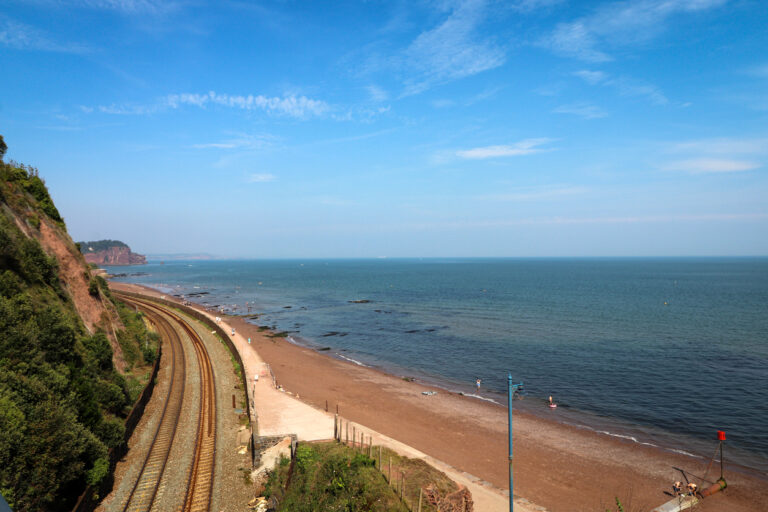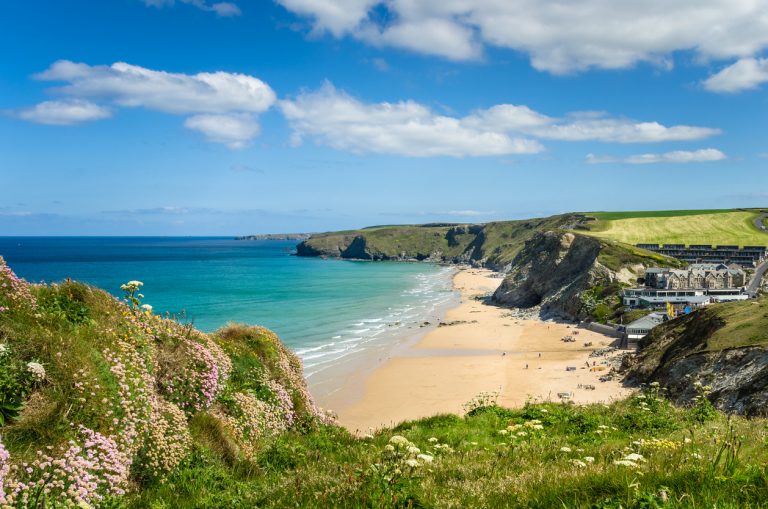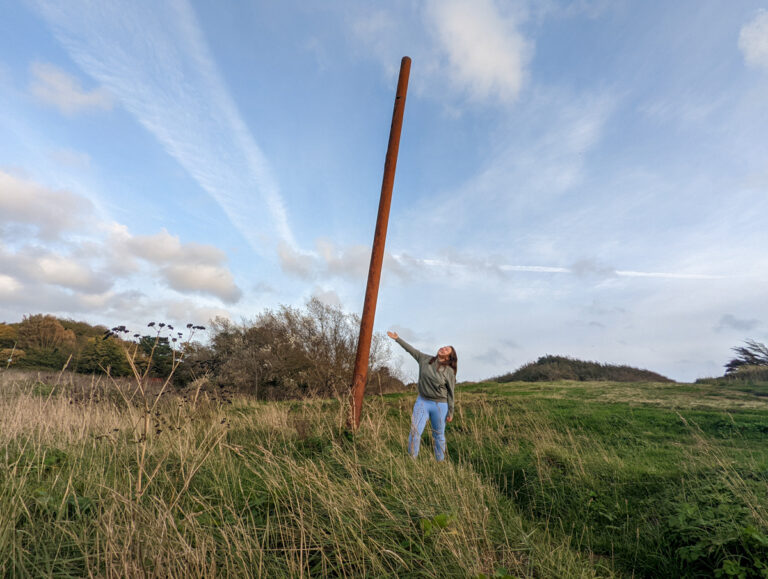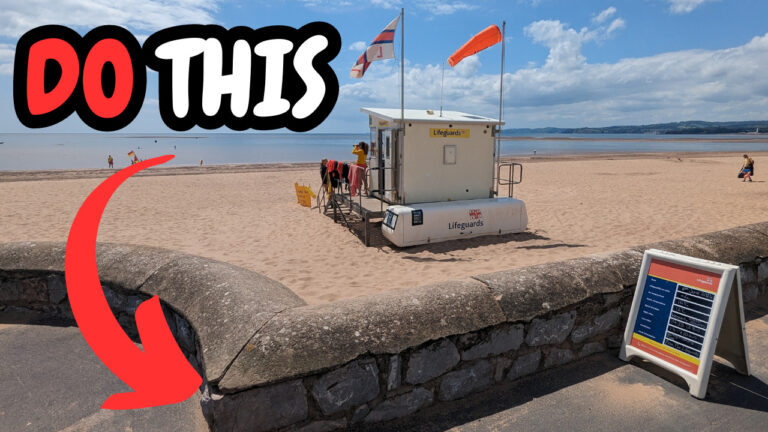Devon Jurassic Coast: things to do and complete guide
Are you planning to visit the Devon Jurassic Coast? Check out our full guide, bursting with the very best things to do!
Step foot onto a shoreline where time has left its marks etched deep into the rugged cliffs and where the land speaks of a story stretching back hundreds of millions of years.
This is the Devon Jurassic Coast, an ancient and stunning part of the country that offers a tantalising blend of geology, history, and natural beauty.
I live right by Devon’s Jurassic Coast – in the town of Exmouth (a short walk from Orcombe Point, which is the official start!), and I think it’s an underrated gem that deserves more attention.
Dorset’s more famous for the Jurassic Coast, but did you know that it stretches into East Devon, and this part is actually the oldest?
Exmouth and Budleigh Salterton are renowned for their bright orange cliffs, but you won’t believe the stories that are lurking underneath!
Here’s all you need to know about visiting Devon’s Jurassic Coast.
This blog post may contain affiliate links.
About Devon Jurassic Coast

While the Jurassic Coast is a term more often associated with Dorset, I think that East Devon’s is even more fascinating (although I am biased, as a resident!).
For starters, the Jurassic Coast is the only natural UNESCO World Heritage Site in England.
And a big reason that it has this status is because it provides a walk through time – it’s the most complete Mezoic era record in the world.
So, when you’re travelling through the Jurassic Coast, you’re going back 250 million years in history.
And the oldest part? Right here in Exmouth.
In fact, the Devon side is primarily Triassic, not Jurassic.
How was the Devon Jurassic Coast formed?
Instead of the seaside we see today, the Devon coast was once part of a sprawling, baking-hot desert – around the same latitude as the Sahara in Africa.
At this time – during the Triassic period – the continents were all one supercontinent called Pangea.
Over hundreds of millions of years, through the shifting and drifting of tectonic plates, this former desert found its way to the place we now call Devon, with the Jurassic and Cretaceous sections being laid down along the way.
Things to do on the Devon Jurassic Coast
The best things to do on the Devon Jurassic Coast include hiking along the Jurassic Coast Path, boat trips from Exmouth to see the bright orange cliffs, fossil hunting, watersports, seeing Orcombe Point and exploring the Beer Quarry Caves.
1. Walk on the South West Coast Path
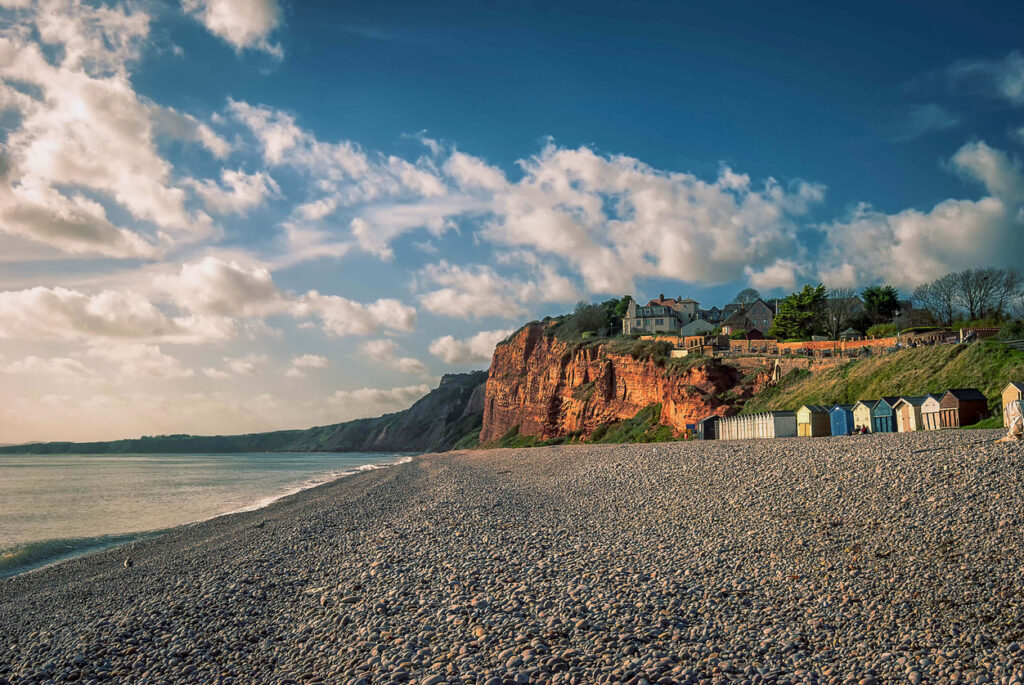
Winding through 630 miles of breathtaking landscapes, the South West Coast Path is the UK’s longest hiking trail.
95 miles of it traverse the Jurassic Coast, 30 of which are in East Devon.
The Jurassic Coast Path unveils a vista that’s a beautiful menagerie of red cliffs, shimmering beaches, and verdant countryside.
Here are some excellent hikes that you can take in this section of the Jurassic Coast path in all its glory:
Exmouth to Budleigh Salterton
Starting at the iconic Orcombe Point, this fairly easy 7-mile hike will give you a fantastic introduction to the Devon section of the Jurassic Coast.
You’ll bypass bright red cliffs, gentle waves and even walk through a temperate rainforest.
The trail concludes at the tranquil Budleigh Salterton, where you can take a bus back to Exmouth.
Here’s my full Exmouth to Budleigh Salterton hiking guide.
Sidmouth to Branscombe
Covering around five miles, this trail includes high points like Salcombe Hill Cliff and Higher and Lower Dunscombe Cliffs, with spectacular views literally every step of the way.
It terminates in the gorgeous village of Branscombe, famous for its thatched-roof cottages.
For your return journey, the 899 bus connects the two settlements.
Beer to Seaton
Short but sweet, this 2-mile walk is suitable for all fitness levels.
Starting from the historic village of Beer, the path hugs the coastline, providing breathtaking views of the Jurassic Coast.
Arriving in Seaton, you can relax on the beach or even hop on the charming tramway that runs through the Axe Valley.
The 885 bus connects the two settlements for a return journey.
Budleigh Salterton – Otterton – Ladram Bay circular
This route starts and ends in Budleigh Salterton.
Follow the Otter River upstream before reaching the picturesque village of Otterton, from which you can follow some country roads and public access fields to Ladram Bay (you’ll need a map for this section).
Then, follow the South West Coast Path back to Budleigh!
Check out my Exmouth to Otterton day hiking guide for some information about this route!
2. Stuart Line Cruises boat trips from Exmouth

Cast off into the gentle waters of the Jurassic Coast on a Stuart Line Cruise tour from Exmouth.
These tours let you absorb the area’s geological history from a unique vantage point.
You’ll sail beneath towering red cliffs that blaze vibrantly in the sunlight.
I embarked on the Jurassic Coast cruise last year, which took us along Exmouth Beach, past Budleigh Salterton and to the craggy Triassic rocks of Ladram Bay.
We were kept informed and entertained by the guide throughout, who explained all of the geological wonders we were gazing at in great detail.
If you want your trip to feel even more Devonshire, you can even add a cream tea to your booking!
3. Relax on the Jurassic Coast’s beaches
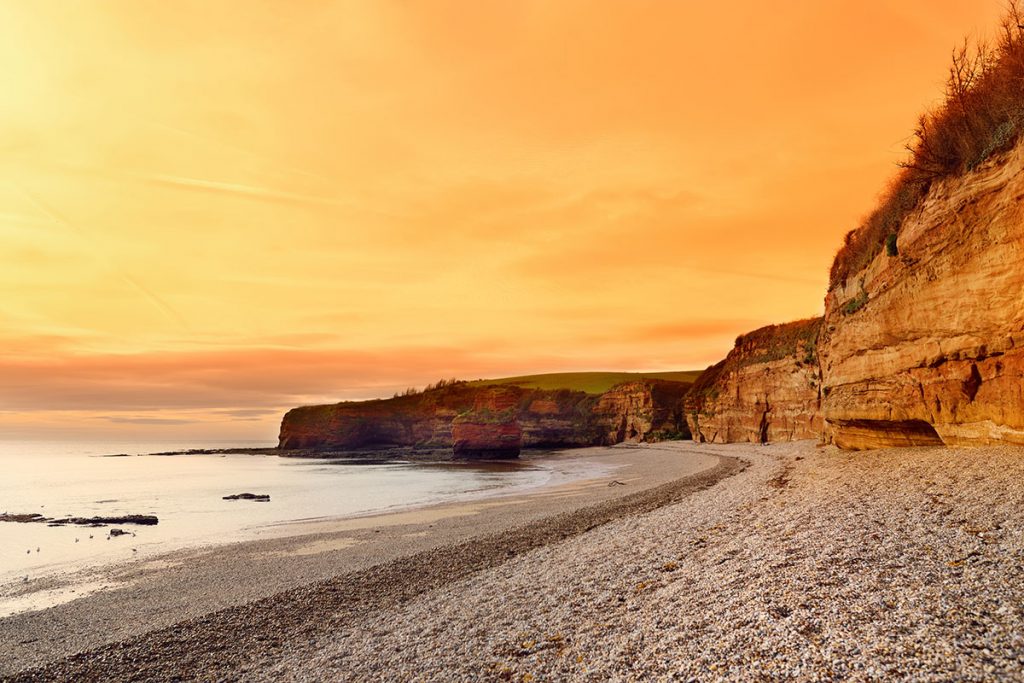
Fancy doing a whole lot of nothing?
You’re in luck because one of the best ways to enjoy the Jurassic Coast is to simply sit on its beaches and watch the world go by!
The Devon Jurassic Coast is adorned with a string of splendid beaches.
Ladram Bay Beach is nestled between the striking red sandstone cliffs, boasting serene waters, pebble beaches, and dramatic rock stacks.
That being said, it’s owned by the caravan site, and in the summer is closed to non-residents.
Branscombe Beach brings a distinct charm with its expansive stretch of pebbles, hemmed by the serene countryside.
Of course, you could always kick back on the two-mile-long Exmouth Beach, enjoying the vistas of Orcombe Point in the distance.
4. Hike to Orcombe Point – the start of the Jurassic Coast

Speaking of Orcombe Point…
Sitting at the very beginning of the Jurassic Coast, Orcombe Point is where you’ll find geological formations dating back over 250 million years.
The spot’s marked with the Geoneedle, an obelisk built from different rocks found along the Jurassic Coast, which serves as a visual timeline of the various geological ages represented along the coast.
It was unveiled by the then-Prince Charles back in 2002 to commemorate the Jurassic Coast’s admission as a UNESCO World Heritage Site.
5. Go Fossil Hunting
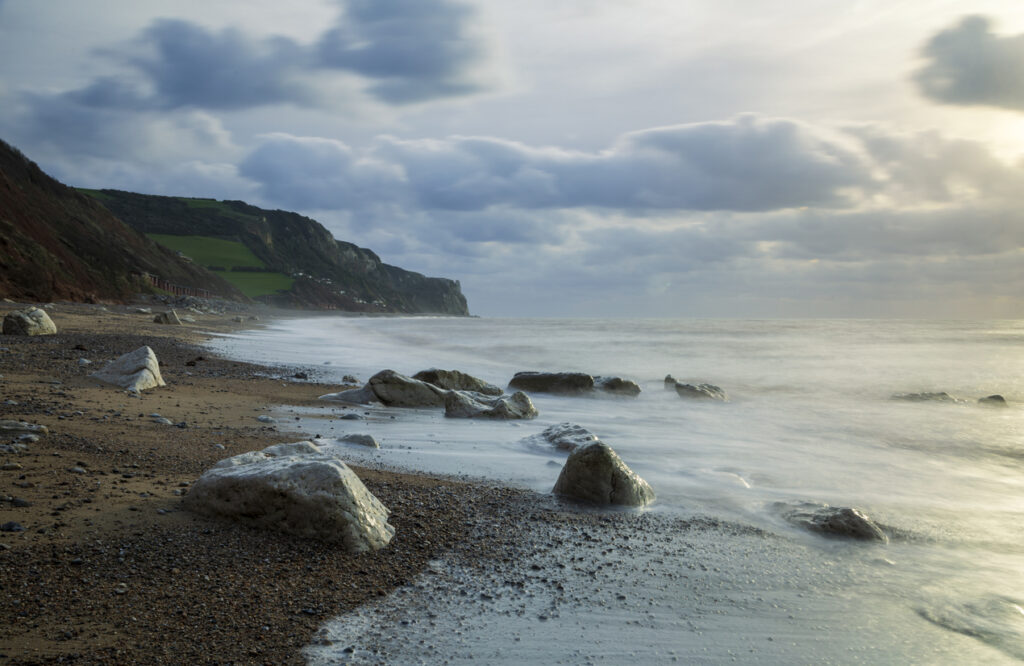
Fossil hunting is an integral part of any Jurassic Coast experience!
While Dorset is more famous for its fossil hunting opportunities, Branscombe is a particularly good place to try it out in East Devon.
This area’s prone to cliff falls – do be careful while exploring the cliffs – but each reveals another chance to discover fossils of ancient marine life.
Local guidelines recommend searching for fossils among the loose pebbles and stones on the beach, especially after storms when new material has been dislodged.
Always follow the Fossil Collecting Code of Conduct to ensure you’re being safe and responsible.
6. Watersports in Exmouth or Seaton Bay

Exmouth and Seaton Bay offer a plethora of watersports, ideal for anyone who’s seeking a slice of adventure!
In Exmouth, the calm waters of the Exe Estuary and sheltered Lyme Bay make it an ideal location for paddleboarding and windsurfing, particularly for beginners.
Rent equipment or take lessons from local company Edge Watersports.
If you’re after a bit more thrill, kitesurfing is a popular option, with the consistent wind conditions making Exmouth a premier spot for this sport.
Seaton Bay also has plenty of water sports opportunities.
Paddle out from the beach to gain a unique perspective on the striking coastline and, if you’re lucky, you might encounter some local marine life along the way.
7. Go back in time at Beer Quarry Caves
Step into the cool chambers of the Beer Quarry Caves, and you’ll be instantly transported back 2,000 years.
This vast complex of caves in the village of Beer has provided high-quality ‘Beer Stone’ since Roman times.
The stone extracted from these caves has been sought after for centuries for its workability and durability, leading to its use in 24 cathedrals around the UK, Windsor Castle, and even parts of the Tower of London.
Work ceased in 1920, leaving behind a spectacular cavern-like interior that almost resembles a natural cathedral.
The tours offered take you deep into the caverns, where you’ll hear tales of the men who worked in these remarkable conditions. It’s a truly immersive step back in time.
8. Visit historic villages in East Devon
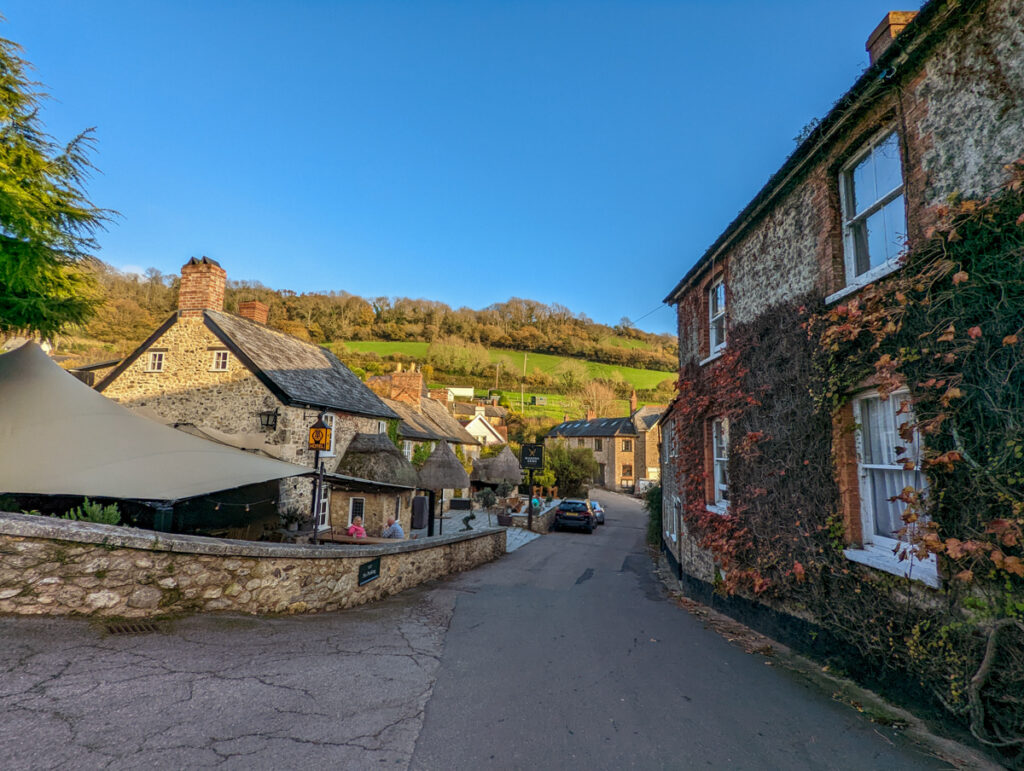
Don’t miss exploring some of East Devon’s most charming historic villages while you’re exploring the coastline and its surroundings.
Branscombe, nestled in a verdant valley that opens to the sea, is one of the most picturesque and tranquil spots in Devon.
Its thatched cottages, ancient Forge (the oldest thatched-roof working forge in the country), and the 12th-century St Winifred’s Church all make a leisurely stroll through the village a walk back in time.
After exploring, why not enjoy a local ale or lunch in one of the village’s traditional pubs? I love the Mason’s Arms (where I dined on a delicious veggie fish and chips a few months ago!).
Inland a little, you’ll find lovely Otterton, located on the banks of the River Otter.
The village is renowned for its beautifully preserved thatched houses and the working Otterton Mill, where you can watch the ancient art of flour making.
And don’t miss East Budleigh.
Famous for being the birthplace of Sir Walter Raleigh, a famous Elizabethan explorer, East Budleigh boasts thatched roof cottages lined up along a narrow lane.
It’s a photographer’s delight!
9. Go hiking – inland!

Looking for a change of scenery?
There are also numerous countryside walks inland, so you can enjoy the rolling hills of East Devon along with the dramatic Jurassic Coastline.
The Exe Estuary Trail is a well-established route following the river Exe around the estuary.
The trail, largely flat and spanning around 26 miles (up from Exmouth to Exeter and then back down to Dawlish Warren), it’s perfect for cyclists and walkers alike.
As you traverse the trail, keep an eye out for the abundant birdlife that inhabits the estuary – the railway line spanning from Exmouth to Exeter is named “The Avocet Line” after the birds in the area.
Alternatively, explore the East Devon Way, a 40-mile route that crosses the heart of the East Devon Area of Outstanding Natural Beauty (AONB).
It winds through a diverse tapestry of landscapes, from heathlands blanketed in vibrant gorse and heather to ancient woodland and quiet country lanes.
Whether you choose to tackle the whole route or select individual sections, the East Devon Way is a must for those wanting to explore the area’s rich and varied inland scenery.
It’s definitely one of the best things to do in East Devon!
Where to stay on the Jurassic Coast in Devon
There are a few excellent places to stay on Devon’s Jurassic Coast, as the coastline is dotted with charming towns and villages. Here are the main places to stay:
Exmouth
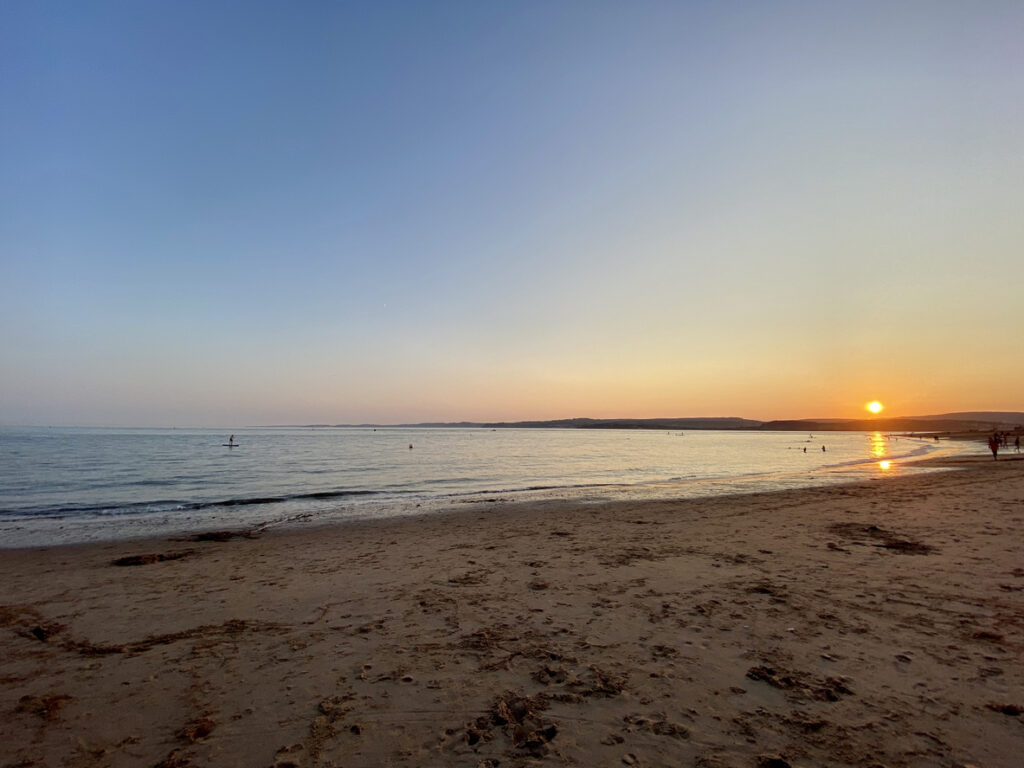
Exmouth, the gateway to the Devon Jurassic Coast, offers an array of accommodations to cater to all tastes.
I live in Exmouth – so I’m a little biased – but I always recommend a stop here when exploring the East Devon coast.
My family and friends have stayed in the Royal Beacon Hotel, in a prime location with stunning sea views.
With its historic charm, comfortable rooms, and excellent service, it’s an ideal base for exploring the coastline and all of the best things to do in Exmouth.
Budleigh Salterton
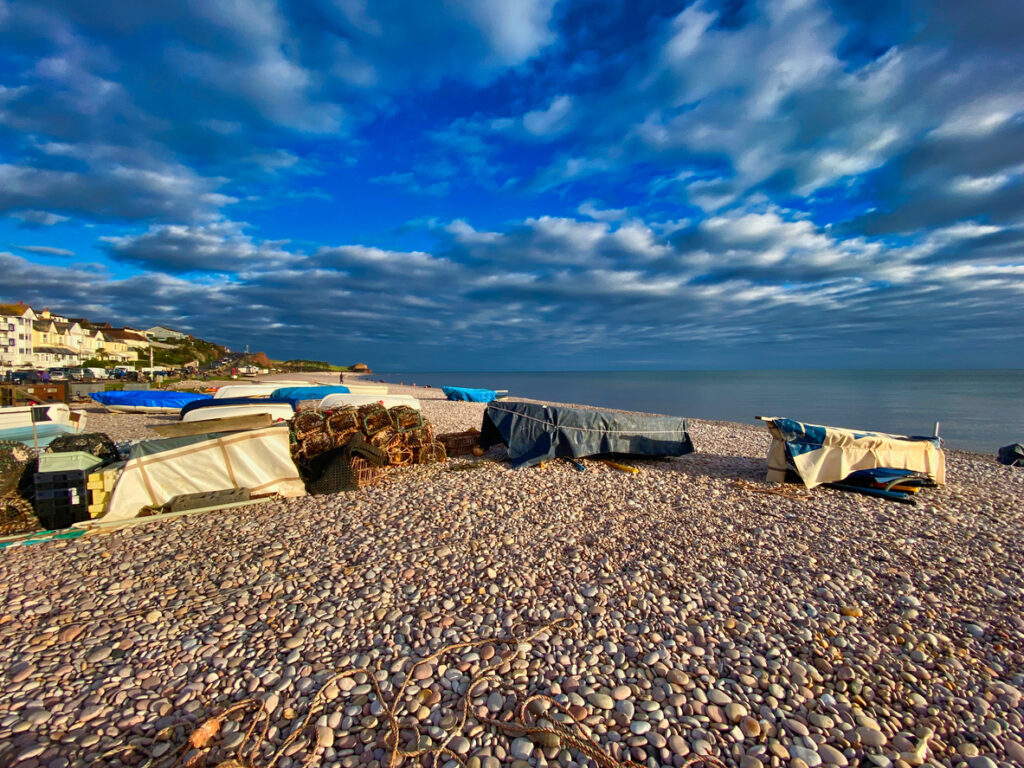
Budleigh Salterton, with its peaceful, high-end atmosphere and beautiful scenery, is a charming spot to rest.
The Long Range Hotel is a fantastic choice, offering comfortable, modern rooms and a lush, tranquil garden.
The hotel’s location is ideal, being a short walk from the town centre and the stunning pebble beach.
Here are all the best things to do in Budleigh Salterton.
Sidmouth
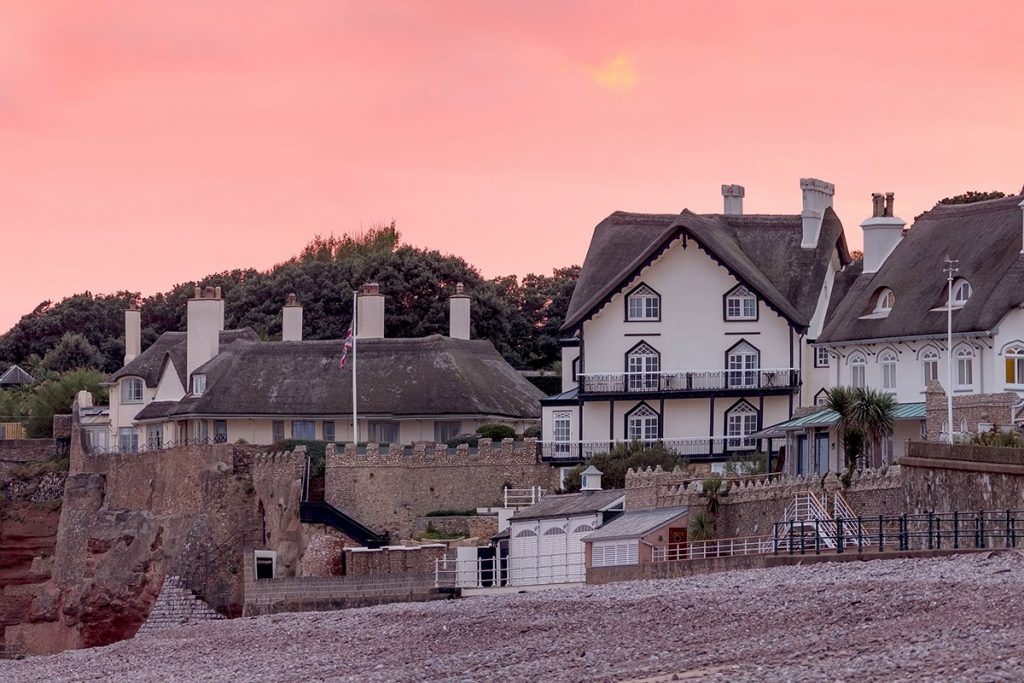
Sidmouth, known for its Regency history and beautiful gardens, offers a mix of traditional charm and modern comfort.
A standout is the Victoria Hotel, an elegant and luxurious with breathtaking views of Lyme Bay and the Jurassic Coast.
It sits in five acres of gardens and even has an outdoor swimming pool.
Here’s a selection of the best things to do in Sidmouth.
Branscombe
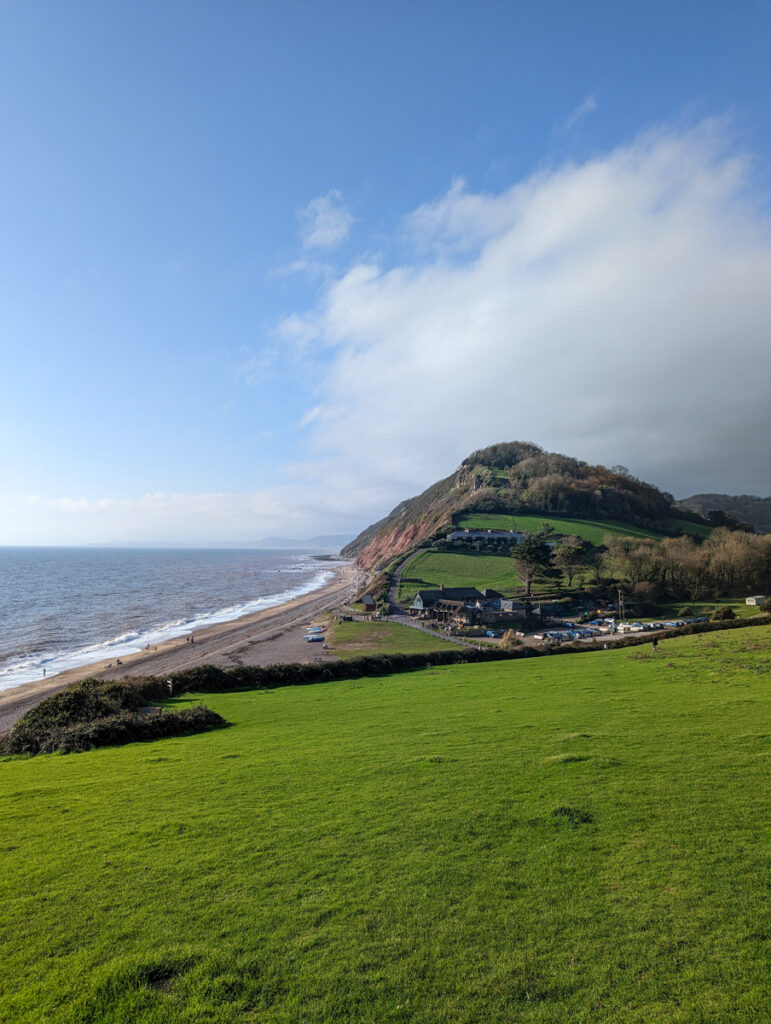
For those seeking a more rural retreat, Branscombe offers a tranquil escape from the hustle and bustle.
The Masons Arms Inn, a charming 14th-century hotel located in the heart of the village, offers cosy and comfortable rooms, a superb restaurant and a delightful beer garden.
Click here to read about the best things to do in Branscombe.
Beer
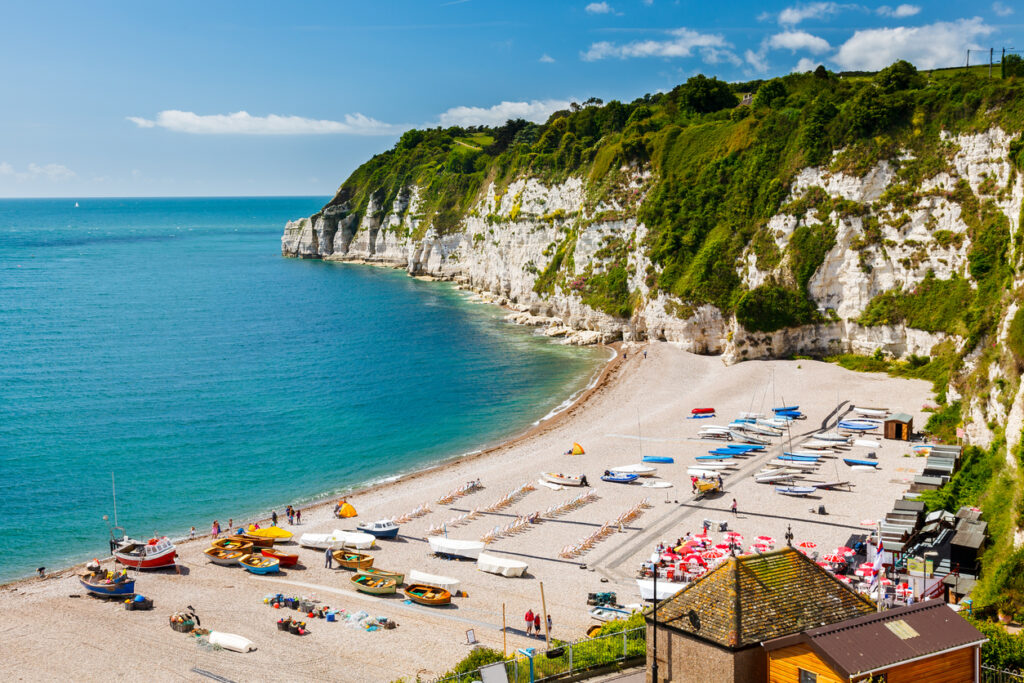
The picturesque fishing village of Beer provides a serene base for coastal exploration.
The Dolphin Hotel is an excellent option here.
This establishment features comfortable rooms, delicious food and a warm welcome, right in the heart of the village.
Seaton
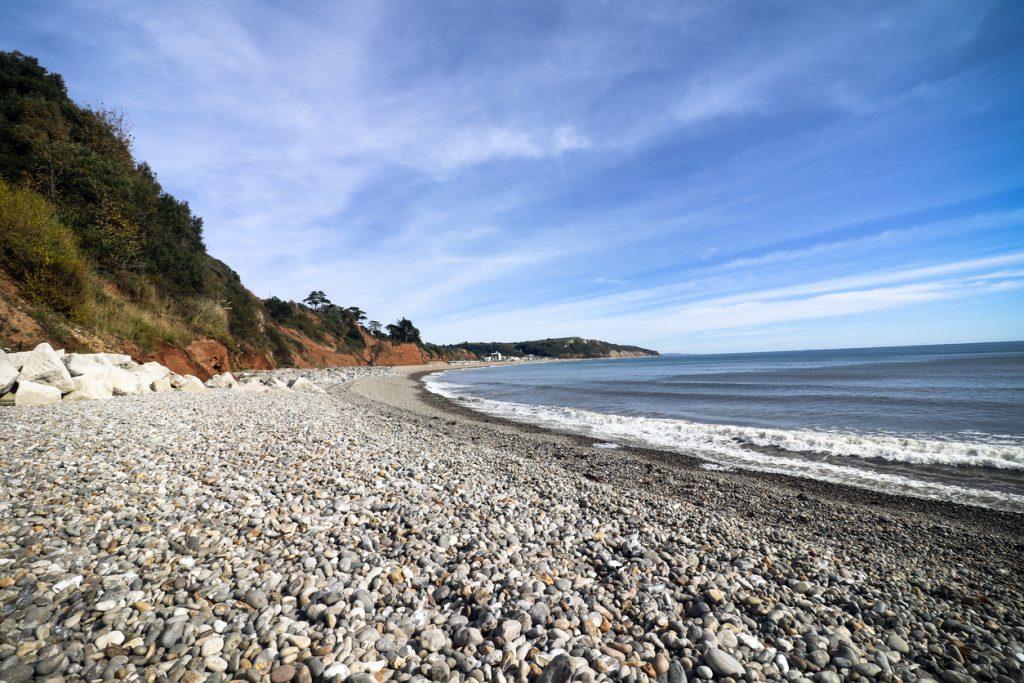
Seaton is known for its natural beauty, offering easy access to both the coast and the Axe Valley.
The Eyre Court Hotel is a popular choice in Seaton.
This small, family-run hotel is conveniently located in the town centre, a short walk from the seafront, and offers comfortable boutique-style rooms, exceptional food and friendly service.
Safety tips for exploring the Devon Jurassic Coast
While you’re exploring the Jurassic Coast in Devon, there are a few very important safety considerations to bear in mind.
As I live in Exmouth, I often hear about incidents that happen on the coast. They are rare – but they do happen.
However, nearly all of these incidents can be avoided with a little common sense.
So be sure to follow these tips while you’re exploring our coastline:
- Always stay on the designated paths when exploring cliff edges. Venturing away from the path increases the risk of cliff falls.
- Similarly, ensure dogs don’t approach cliff edges. If necessary, keep them on a lead for their safety.
- Avoid sitting directly under cliffs on beaches as there can be unexpected rockfalls.
- Only swim in areas that have been designated as safe. These areas are usually marked and supervised.
- If you have any concerns about swimming or water safety, don’t hesitate to speak to a lifeguard. They’re there to help and ensure your safety.
- When participating in watersports, pay careful attention to safety demonstrations and follow all guidelines provided.
- Check weather conditions before you embark on any outdoor activity. The weather can change quickly, especially at sea.
- Carry a map or have a map app downloaded and ensure someone knows where you are going and when you plan to return, especially when undertaking longer hikes or water activities.
- Make sure you’re properly equipped for your activities. This might include water, sunblock, appropriate footwear, and warm clothing.
FAQs about visiting the Jurassic Coast in East Devon
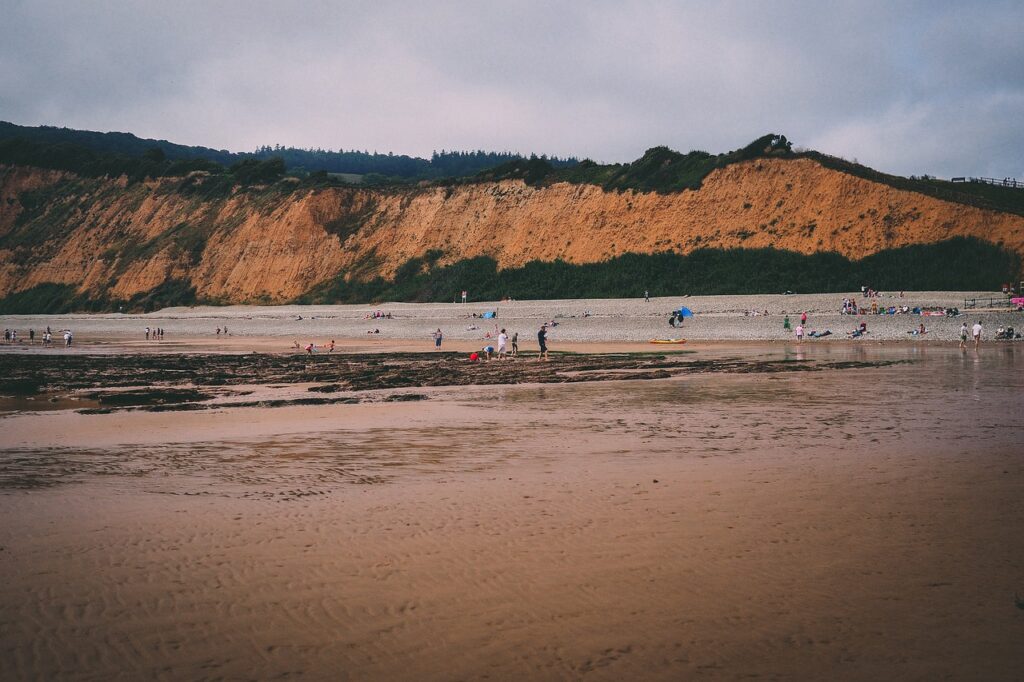
When is the best time to visit the Devon Jurassic Coast?
While the Devon Jurassic Coast offers unique charms all year round, the best time to visit is usually during the late spring and summer, between May and September.
However, do bear in mind that the end of July and August are school summer holidays, and Devon can be busy during these months!
East Devon’s not as popular as other spots in the West Country – it’s nothing like Cornwall in August – but if you want a more relaxed Jurassic Coast trip, I recommend visiting in June, early July or September.
Can I swim at the beaches along the Devon Jurassic Coast?
You can swim at many of the beaches along the coast, but be aware of local safety guidelines.
Tides, undercurrents, and weather conditions can change rapidly – there are usually flags to indicate where it’s safe to do so, so always make sure you abide by these.
If you’re in any doubt, ask a lifeguard.
Is there public transport along the Devon Jurassic Coast?
I mean, technically there is… but East Devon isn’t known for its excellent public transport connections.
There is a network of bus services that connect the various towns and villages along the coast – but check the timetables and plan in advance, as some of them only run a few times per day!
Are there places to eat along the Jurassic Coast in Devon?
Absolutely! There are towns and villages along the coast, so you’ll find a variety of dining options in each.
There are plenty of great restaurants in Exmouth and each village at least has a village pub.
Be sure to try the locally-made Devonshire cream tea – just remember, when you’re in Devon, you have to put the cream on first!
Is the Devon Jurassic Coast family-friendly?
Yes, the Devon Jurassic Coast is a great destination for families.
There are plenty of activities that kids will enjoy, including fossil hunting, beachcombing, visiting the Beer Quarry Caves, and participating in watersports.
Other attractions include the Sidmouth Donkey Sanctuary, Bicton Gardens and Exmouth World of Country Life.
Are you ready to visit the Devon Jurassic Coast?
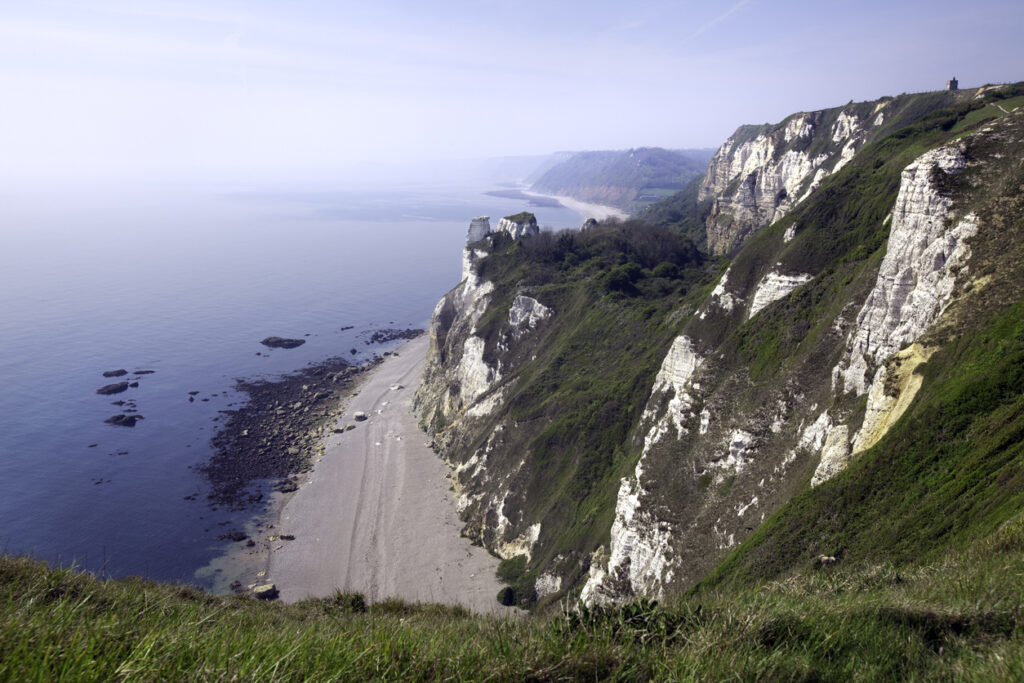
With its astonishing geology, breathtaking coastal views, charming historic villages, and the myriad of experiences on offer, it’s no wonder this corner of England has been designated a World Heritage Site.
Whether you’re a hardcore hiker, a budding geologist, a watersports enthusiast, or someone who simply enjoys tranquil scenic beauty, the Devon Jurassic Coast has something for everyone!

